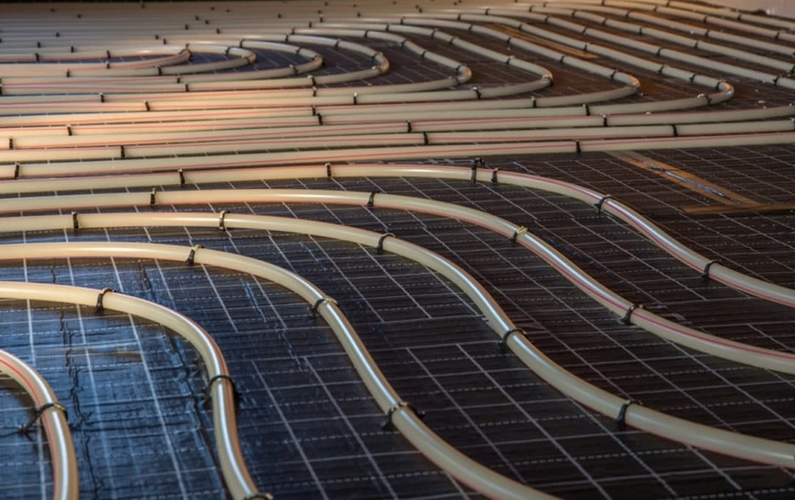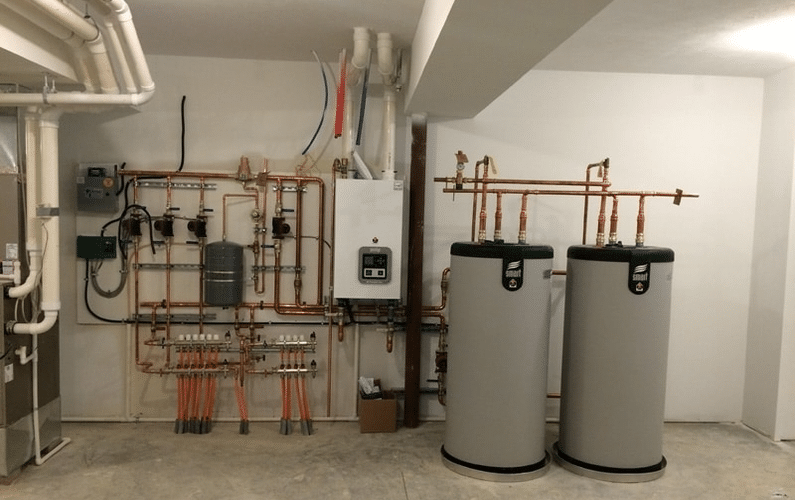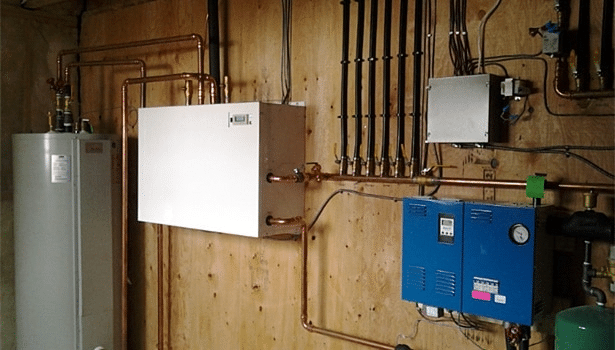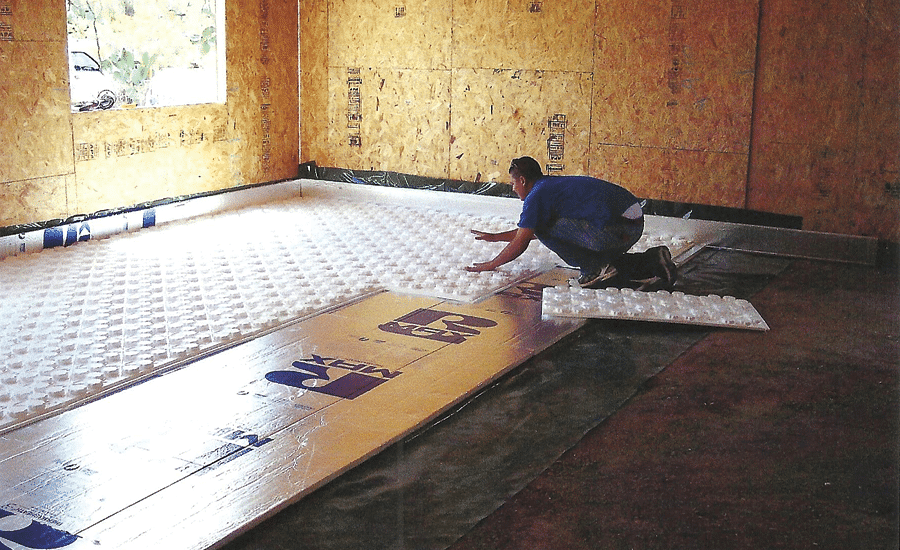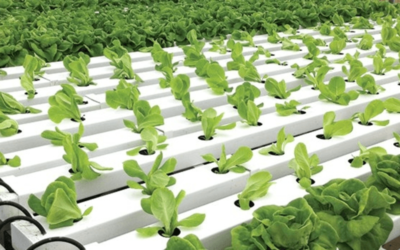The world is shifting towards green and eco-lifestyles and systems such as hydronics radiant heating and cooling truly embrace this fact. If you are thinking that hydronic radiant heating and cooling is a new concept, it is not, its roots lie way back in 5000BC (around 7,018 years ago) when Koreans (the natives of Korea, Asia) used to heat their homes with the help of “ondol”. From that time, this concept was practiced in various parts of the world to gain comfort in all sorts of climatic conditions, whether moderate or extreme.
With this popular eco-lifestyle concept, the temperature of a residential dwelling is increased or decreased by circulating cold or hot water via flexible cross linked polyethylene (PEX) tubing placed within the walls, ceilings or underneath the floor. The same PEX piping system is used to transport the hot water for heating and cold water for cooling. This system either radiates the heat from walls, ceilings, and floors to warm objects and people, or it absorbs the heat back to provide the cooling benefits.
Other Ways to Heat or Cool a Home
Besides hydronics radiant heating and cooling, there are various other ways to heat and cool a house. Today, technology has advanced much, and several methods and equipment used to increase or decrease the temperature of a house are available. Let’s have a look at them:
Heating A Home
Electric Heaters
Electric heaters are the devices used to heat a small area – usually, one or two rooms – and are further divided into the categories – portable and fixed electric heaters. Portable electric heaters are bought cheaply though their operating costs are high and they are mostly ineffective when used to heat large areas. On the other hand, fixed electric heaters are slightly more energy efficient than portable ones. Electric heaters emit high levels of greenhouse gases.
Gas Heaters
Like electric heaters, gas heaters are also available as portable and fixed gas heaters. They run on LPG or natural gas and are used to get radiant or convective heat. Being gas heaters doesn’t mean they don’t always require electricity – with the fan option they need electricity to run the fan to circulate hot air. There are also some decorative appliances that run on gas and are used for heating. Gas heaters also emit greenhouse gases.
Solid Fuels
Solid fuels such as wood, etc. are also used to heat homes. These fuels are mostly used in open fireplaces and stoves, which are an inefficient way to heat a house because around 90% heat energy is lost during this process. Moreover, this method causes a high level of air pollution and when solid fuels like wood are burnt, harmful greenhouse gases are emitted.
The list of heating methods for a home is long and includes other solutions like heat shifters, solar air heaters, micro-cogeneration systems, air conditioners, different kinds of heat pumps, etc.
Cooling A Home
Electric Fans
Fans are the first preference when it comes to cooling a home. Available in two categories such as fixed (wall or ceiling) or portable (floor or table), fans are used to lower the temperature up to 30 C. They are the most affordable cooling option, though inefficient, they have minimum greenhouse impact.
Evaporative Coolers
This is yet another option to cool a home, though not effective in high humidity regions. They are very efficient in low humidity climates – in such climates, air has the capacity to absorb water vapors. To make the best use of these coolers, some windows or doors would be kept open to move hot air out of the house.
Air Conditioners
When the fans or evaporative coolers fail to provide the much-needed cooling, we consider air conditioners. They are known to provide a high level of comfort during high temperatures, this comfort comes at a high cost for their energy usage and has a high emission of greenhouse gases. They are further categorized as portable split air conditioners, portable single-duct units, and wall units.
There are various other cooling methods for a home such as alternative heat exchangers, solar air coolers (they use electricity to operate their fans), advanced heat fans, etc.
Benefits of Using Hydronics Radiant Heating and Cooling
There is no doubt that a hydronics radiant heating and cooling system is the most comfortable, versatile, economical, and eco-friendly way to maintain the temperature of your house. By choosing it, you experience the following benefits:
- The surfaces of an area are cooled or heated, not only the air.
- You experience more comfort because heating and cooling via these systems is uniformly distributed within every area, removing cold or hot spots.
- It does not circulate dust and other allergy-causing particles.
- These systems eliminate all kinds of fan noises, ductwork noises, and start or stop sounds, you live in a clean and quiet environment.
- Your home is divided into zones so that the temperatures are managed individually. Each zone has a different desired temperature.
- You are able to manage your home’s temperature, by setting the temperature yourself for maximum comfort.
- A hydronics system when installed in the floor is compatible with any kind of floor covering such as wood, carpet, slate, stone, tile, laminate, and concrete. Nevertheless, the ideal floor coverings are tile and concrete due to their conductive properties.
Clean and Healthy
A hydronics system provides warmth in a way that is similar to nature (natural convection and radiation). A hydronics system doesn’t burn the air and cause dryness in the environment nor does it cause unpleasant draughts. Moreover, hydronics systems don’t create humidity, noise, or hot spots. These are completely dust-free and free from allergy-causing particles.
Safe and Reliable
When it comes to safety and reliability, hydronics systems are completely sealed, no electrical connections or exposed flames causing fire hazards. The temperature of water circulating in a hydronics system is adjusted to provide optimum comfort in particular rooms.
Cost Effective
The operating cost of a hydronics system is significantly less in comparison to for instance air conditioning, mainly due to the heat pump’s ability to efficiently heat and cool water. The same heat pump heats the eco-home’s hot water, which is stored, and used from the storage tank, as the hot water in the home, or used to maintain or increase the temperature of the home’s zones.
The Unique Qualities of Hydronics Radiant Heating and Cooling
Hydronics radiant heating and cooling systems are the most economical, efficient, and eco-friendly systems. As a green initiative, natural gas or solar water heaters are often used to heat water. The energy consumed is 70 percent less in comparison to electric dependent heating or cooling systems.
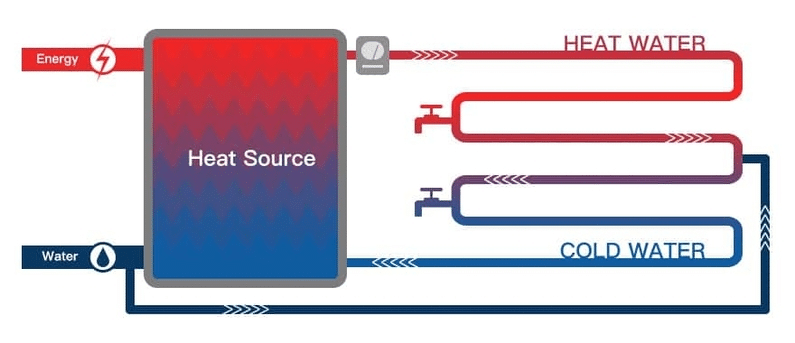
Hydronics System for Homes
Hydronics radiant heating and cooling systems are installed in new homes as well as retrofitted in existing homes. Nevertheless, it is most efficient to design the home with hydronics in mind. Though retrofitting is possible, it isn’t as efficient when done this way, and very costly. With a new home, it is ideal to place the PEX piping system throughout the home while it is being built.
The prime objective with hydronics radiant cooled or heated areas is the thermal comfort of the occupant. You’re able to use the hydronics system by itself or along with the conventional air conditioning systems. The actual mode of operation (cooling/heating) of the system depends on the amount of heat transferred between the area and water. Moreover, to regulate the temperature of different zones of your home, zonal valves and temperature sensors are used, which monitor and transport hot or cold water to a particular zone. These valves manage the flow of hot and cold water to a particular zone, independent from other zones.
In the case of hydronics heating, a heat source (boiler, ideally a heat pump) is used and from it, hot water is transferred all over the house via pipes installed in the walls, ceilings, baseboards, or underneath the floor. As the hot water is transferred to all the required parts of a house, a subtle and uniform warmth is created which gives superior comfort.
Similar to the heating method, cold water is circulated via pipes to cool down the temperature of your home. In comparison to the traditional air conditioning systems which cool the air, hydronics cooling is the most energy-efficient, economical and environmentally-friendly way to radiantly lower or increase the temperature of a home.
The hydronics system regulates the temperature of different zones of the home, including the bathrooms. Whether your bathroom has laminate, linoleum, or tile floors, hydronics radiant heating and cooling systems distribute the required temperature even to the bathrooms, and safely.
Heat Pumps and Hydronics
For hydronics radiant heating or cooling systems, multi-functional heat pumps are best suited. A single heat pump is able to increase or decrease the temperature of the required water supply. These pumps offer efficiency, cost savings, and prevent loss of heat energy. Moreover, multi-functional heat pumps feature a reversing valve which allows the outdoor heat exchanger (source) and indoor heat exchanger (load) to interchange roles. This means that the load-side heat exchanger provides either cooling or heating.
Insulation is the Key
To obtain the best results, ensure the home is well-insulated. Ideally, insulation is required in the floor, ceiling, walls – in the wall cavity even in brick and mortar homes, double or triple glazing, and around water pipes. Yes, the aforementioned lists 5 different types of insulation. The more efficiently the home is insulated, the more efficiently the home retains its temperature, and the less energy is required to maintain the home’s comfort. A well-insulated home maximally limits the flow of heated and cold temperatures inside and outside the home, thereby obtaining optimum results.
Though it is possible to retrofit hydronics systems in an existing house, they produce the optimal results and cost efficiency when designed and built from the ground up into a new home. To install this system’s pipes in an existing home, and to insulate an existing home is possible though difficult and costly.
Smart Technology
Whether it is your appliances, your laptop or your smartphone, smart technology is used everywhere to make life easier. The same with using smart technology combined with hydronics radiant heating and cooling, to maximize living an environmentally-friendly eco-lifestyle.
The benefits of hydronics radiant heating and cooling are enhanced with smart technologies. Smart technologies are employed to reduce energy usage in a big way (lower energy bills).
The smart technology in hydronics systems lets you manage the temperature of your home optimally.
An example. Say the Hydronics is set at 20° and the system shows, that particular temperature uses excessive electricity, by lowering the required temperature by 0.5° at a time, you’re able to see how those adjustments affect the electricity usage. Furthermore, say that lowering the required temperature by 1° results in drastically reduced electricity usage, the choice is then available to you to run the home at 20° at a high cost, or at 1° lower thereby saving drastically on electricity costs.
Keeping in mind this would not apply when the sun is generating the electricity, thus the aforementioned would apply when the sun sets and the batteries are being used, or the utility grid is being used.

